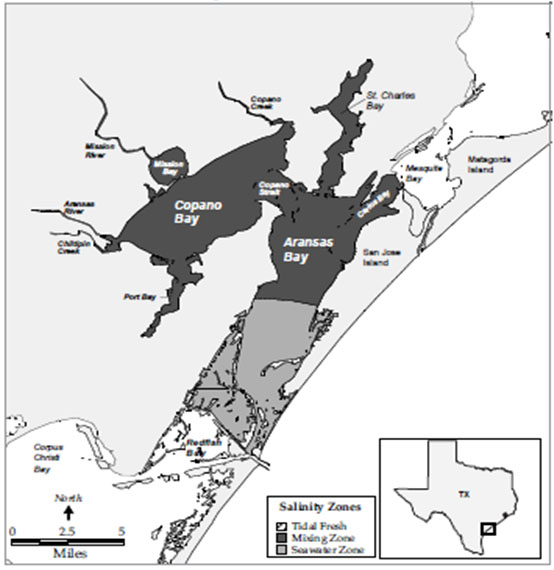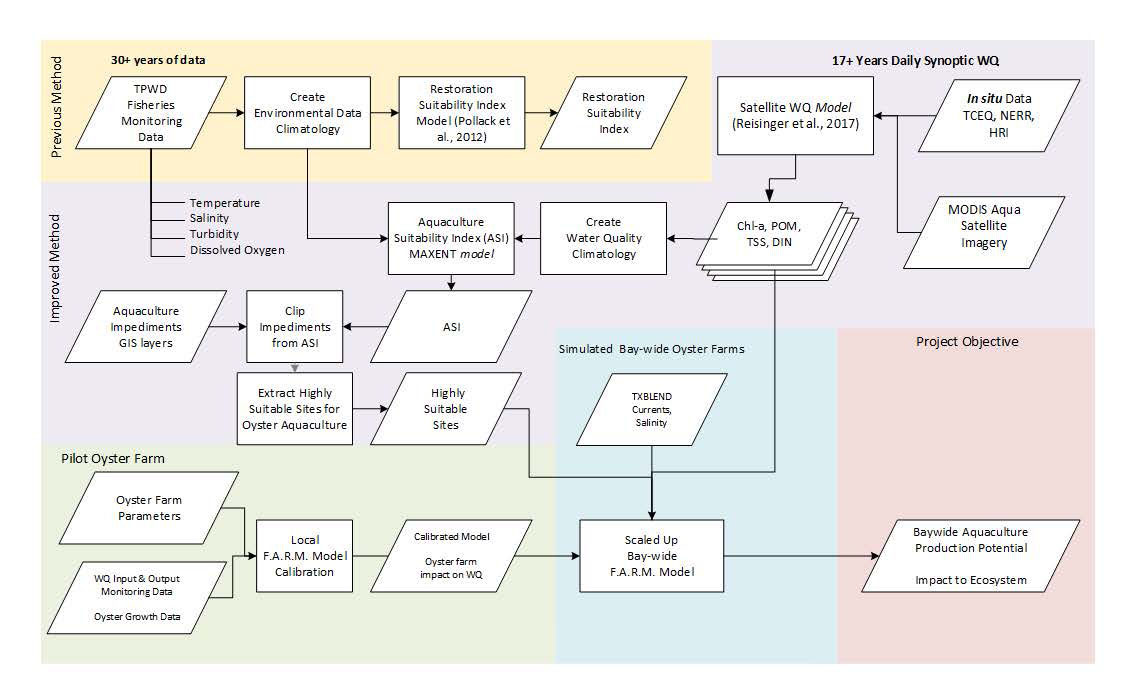Oyster populations in Copano Bay, Texas, have declined to roughly one percent of historic populations, and the once thriving commercial oyster fishery in Texas reflects this decline. Aquaculture is seen as a way to reverse this trend. On September 1, 2019, Texas Governor Greg Abbott signed a bill into law that allows oyster aquaculture on the state’s Gulf Coast. Before passage of this law, Texas was the only coastal state in the U.S. that did not allow oyster aquaculture along its coast. We seek to develop tools that will help identify locations in Texas that are suitable for oyster aquaculture and will provide the basis for development of a sustainable industry that maximizes oyster harvest, while maintaining water quality at desirable levels and reducing conflicts with other users of the water body. The goal is for Copano Bay to once again have a thriving, sustainable oyster aquaculture industry; good water quality; and shared use by growers, recreational users, and others.

Why We Care
Texas oyster populations have decreased significantly in recent years due to above-normal freshwater intrusion, overfishing, and storm-related (Hurricane Harvey, 2017) damage to fishing infrastructure. One possible solution to partially reverse the decline and increase commercially available oysters is development of a Texas oyster aquaculture industry. The September 2019 law approving aquaculture in Texas coastal waters is being viewed with optimism as a way to reduce dependence on non-local oysters and to build a local, sustainable industry to increase the local supply of seafood. But the industry must be developed carefully to avoid water body use conflicts and unintended degradation of water quality by over population of cultured oysters.
What We Are Doing
In this Texas Sea Grant funded project, we are developing an oyster aquaculture suitability index (ASI) to support development of the oyster aquaculture industry in Texas. Working with multi-disciplinary partners from Texas A&M University and Longline Environment, Ltd., we will use a Geographic Information System (GIS)–based approach to develop an ASI for Copano Bay that will evaluate this small bay’s potential to support caged oyster aquaculture.
The ASI integrates map-based water body characteristics (e.g., water and sediment quality data, physical bay characteristics, uses of water body) and modeling of potential oyster production (e.g., oyster biomass, biomass density, harvest) to provide a standardized approach in support of the aquaculture industry. The ASI will be used to identify potential lease areas based on their suitability for successful oyster cultivation. Output from the ASI will be integrated with results from the Farm Aquaculture Resource Management (FARM) model, a local-scale production model that predicts harvest and oyster carrying capacity under various culture scenarios. The analysis will consider factors that make an area unsuitable for leases, such as multiple-use conflicts regarding navigation, essential marine and seagrass habitat, socioeconomics, and environmental pollution. The research team will also analyze potential oyster production, and determine oyster population thresholds needed to maintain water quality. While oysters are well known for cleaning water through filter feeding that removes nutrients and particulates, too many oysters can create a buildup of bio-deposits on the seafloor that degrades water quality.
The tool we are developing will identify geographic locations expected to result in successful oyster growth and will include oyster carrying capacity thresholds, specific to those geographic locations, above which water quality will decline. The tool will be used by growers, resource managers, and permitting agencies to develop the new Texas oyster industry in a smart and sustainable way.
Benefits of Our Work
This project will provide a key step in the development of oyster aquaculture in Texas bays. Integration of ASI and FARM models will provide a stronger basis for aquaculture siting and development in Texas and help minimize user conflict and adverse environmental interactions in a state where bay-based aquaculture has not yet been established. Ultimately, the tool developed by the project team can be used by growers, resource managers, and regulators to inform permitting and regulatory policy facilitating establishment of oyster aquaculture, promoting healthy and resilient coastal ecosystems, and supporting economic development of Texas coastal communities, working waterfronts, seafood supplies, and retail sales.

